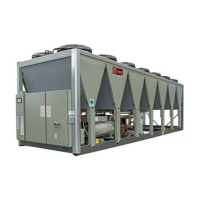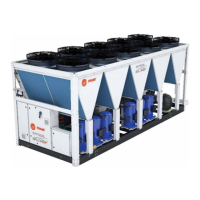RLC-SVX19G-GB
167
11UNT-PRC002-GB
Sound power levels
Discharge
Measurement conditions:
Measurements taken in a room adjacent to the room containing the FWD, at the outlet of the rectangular duct (1.5 m
long) fixed to its discharge opening.
Fan Power level in dB(A), per Hz frequency band Overall power
Unit speed 125 250 500 1000 2000 4000 8000 dB(A)
1 55 50 42 37 37 31 30 46
FWD 08 2 57 54 47 40 30 38 40 50
3 58 57 50 42 32 40 43 53
1 57 51 45 42 34 33 28 48
FWD 10 2 58 54 48 45 38 39 35 51
3 60 58 50 48 40 42 39 54
1 57 51 45 42 34 33 28 48
FWD 12 2 58 54 48 45 38 39 35 51
3 60 58 50 48 40 42 39 54
1 56 62 50 48 39 38 36 56
FWD 14 2 61 66 55 53 47 46 45 60
3 63 69 58 56 50 50 49 63
1 57 63 51 49 40 39 37 57
FWD 20 2 61 66 55 53 47 46 45 60
3 63 69 58 56 50 50 49 63
Intake
Measurement conditions:
Measurements taken at the horizontal air intake.
Fan Power level in dB(A), per Hz frequency band Overall power
Unit speed 125 250 500 1000 2000 4000 8000 dB(A)
1 56 55 55 53 46 45 42 57
FWD 08 2 63 62 60 60 53 53 53 64
3 66 65 63 62 56 55 57 67
1 62 58 55 58 51 48 44 61
FWD 10 2 66 63 60 62 56 55 52 66
3 70 67 63 65 59 59 57 69
1 62 58 55 58 51 48 44 61
FWD 12 2 66 63 60 62 56 55 52 66
3 70 67 63 65 59 59 57 69
1 66 65 65 65 57 50 46 68
FWD 14 2 73 72 69 71 64 59 57 74
3 78 76 73 75 69 64 63 78
1 68 72 64 64 56 52 50 69
FWD 20 2 76 76 68 71 65 61 61 75
3 78 79 71 74 69 66 66 78
Periodic Maintenance
Low side Charge-isolation Procedure
After normal shutdown, most of the charge resides in the
evaporator. Running cold water through the evaporator
may also drive much of the refrigerant to the evaporator.
1. Make sure the circuit is off.
2. Close the suction-line isolation valve.
3. Close the liquid line service valve.
4. Close the liquid line service valve
5. Manually open the EXV
6. Use a liquid pump or vacuum pump to move
refrigerant from the condenser to the evaporator.
The liquid pump will only be effective if there is a lot
of charge in the condenser. It may be connected to
the condenser drain port on the liquid-line isolation
valve.
Note: If a pump is to be used, connect it before closing
this valve. This port is only isolated when the valve is back
seated. If a vacuum pump is used, then connect it to the
discharge-line service valve near to the oil separator.
A vacuum pump will be required for part of the
procedure.
The evaporator is large enough to hold all the charge, for
any unit, below the centerline of the shell. Therefore, no
special precautions are required to restart the unit after
isolating the charge in the evaporator.
Refrigerant Filter Replacement –
Changing Procedures
A dirty filter is indicated by a temperature gradient
across the filter, corresponding to a pressure drop. If the
temperature downstream of the filter is 4,4°C lower than
the upstream temperature, the filter should be replaced.
A temperature drop can also indicate that the unit is
undercharged.
1. With the unit off, verify that the EXV is closed.
Close the liquid-line isolation valve.
2. Attach the vacuum hose to the service port o the
liquid-line filter flange.
3. Evacuate the refrigerant from the liquid-line and
store.
4. Remove the vacuum hose.
5. Depress the Schrader valve to equalize pressure in
the liquid line with atmospheric pressure.
6. Remove the bolts that retain the filter flange.
7. Remove the old filter element.
8. Inspect the replacement filter element and lubricate
the o-ring with Trane oil advised for the unit
(see general data table).
9. Install the new filter element in the filter housing.
10. Inspect the flange gasket and replace it with a new
one if damaged.
11. Install the flange and torque the bolts to 19-22 Nm
(14-16 lb-ft).
12. Attach the vacuum hose and vacuum the liquid line.
13. Remove the vacuum hose from the liquid and attach
the charging hose.
14. Replace the stored charge in the liquid line.
15. Remove the charging hose.
16. Open the liquid-line isolation valve.
Lubrication System
The lubrication system has been designed to keep most
of the oil lines filled with oil as long as there is a proper
oil level in the oil sump.
The total oil charge can be removed by draining the
oil system, the oil return line from the evaporator, the
evaporator, and the compressor. Very small quantities of
oil may be found in other components.
Proper charging of the oil system is critical to the
reliability of the compressor and chiller. Too little oil
can cause the compressor to run hot and inefficiently.
When taken to an extreme, low oil level may result
in instant failure of the compressor. Too much oil will
result in high oil-circulation rates, which will foul the
condenser and evaporator performances. This will result
in inefficient operation of the chiller. Taken to an extreme,
high oil levels may result in erratic expansion-valve
control or shut down of the chiller due to evaporator
low evaporator refrigerant temperature. Too much oil
may contribute to long term bearing wear. Additionally,
excessive compressor wear is probable when the
compressor is started with the oil lines dry.
• Oil system consists of the following components:
• Compressor
• Oil separator
• Discharge line with service valve
• Oil line from separator to compressor
• Oil line drain (lowest point of the system)
• Oil cooler (with HA & Low temperature brine option)
• Oil temperature sensor
• Oil line shutoff valve with flare service connection
• Oil filter (internal to compressor) with flare-fitting
service connection and Schrader valve
• Oil flow-control valve (internal to the compressor after
the filter)
• Oil return line from evaporator with shutoff valve,
oil filter, and solenoid control valve (for the manifold
compressor circuits only)
Oil charging data.
The oil quantity is written on the nameplate of the unit.
